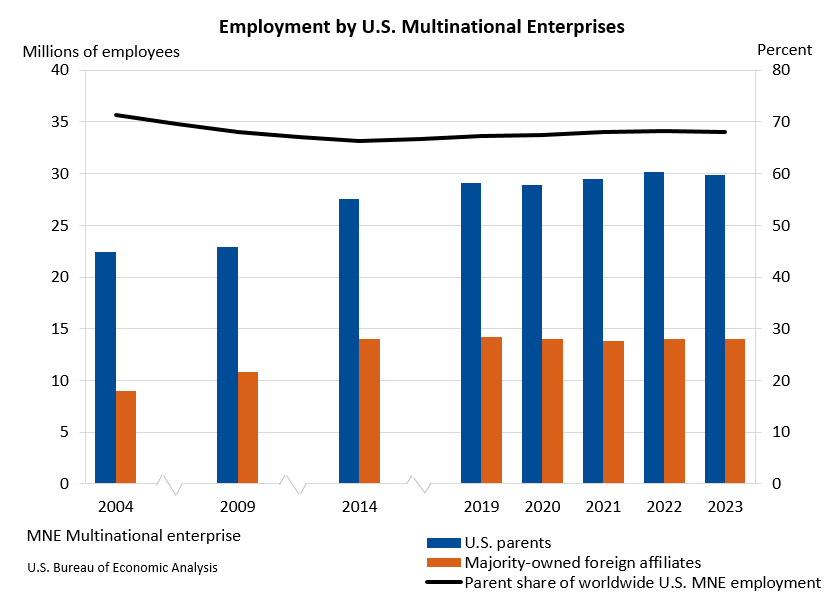Bureau of Economic Analysis
Activities of U.S. Multinational Enterprises, 2023
Worldwide employment by U.S. multinational enterprises decreased 0.4 percent to 43.9 million workers in 2023 (preliminary) from 44.1 million workers in 2022 (revised), according to statistics released today by the U.S. Bureau of Economic Analysis on the operations and finances of U.S. parent companies and their foreign affiliates.
Principal Federal Economic Indicators
Noteworthy
- 2025 News Release Schedule
- Innovation at BEA
- 2025 Annual Updates
- Distribution of Personal Income Nowcast
- New! Services Trade Data for More Countries
- Data Tool: Trade in Value Added
- Updated: RIMS II Regional Multipliers
- Arts and Culture
- Space Economy
- FDI Now in State BEARFACTS
- Quick Guide: Price Indexes
The Latest
Initial Statistics on the Size and Growth of the Digital Economy to be Released Thursday
The Bureau of Economic Analysis will release, for the first time, preliminary statistics and an accompanying report exploring the size and growth of the digital economy at 10:30 a.m. on Thursday, March 15.
The report will be available at BEA’s website, www.bea.gov.
The report will include in its definition of the digital economy three major types of goods and services:
BEA Works with Partners to Understand Differences in Bilateral Trade Statistics
Trade statistics produced by the Bureau of Economic Analysis provide policymakers and other stakeholders with critical information for understanding the role of the United States in the global economy. As the size and complexity of international transactions have increased, BEA is working on a number of fronts to make its trade statistics even better.
January 2018 Trade Gap is $56.6 Billion
The U.S. monthly international trade deficit increased in January 2018 according to the U.S. Bureau of Economic Analysis and the U.S. Census Bureau. The deficit increased from $53.9 billion in December (revised) to $56.6 billion in January, as exports decreased more than imports. The previously published December deficit was $53.1 billion. The goods deficit increased $2.8 billion in January to $76.5 billion. The services surplus increased $0.…
2017 Trade Gap is $568.4 Billion
The U.S. international trade deficit increased in 2017 according to the U.S. Bureau of Economic Analysis and the U.S. Census Bureau. The deficit increased from $504.8 billion in 2016 to $568.4 billion in 2017, as imports increased more than exports. As a percentage of U.S. gross domestic product, the goods and services deficit was 2.9 percent in 2017, up from 2.7 percent in 2016. The goods deficit increased from $752.5 billion in 2016 to $811…
U.S. International Trade in Goods and Services, January 2018
The U.S. monthly international trade deficit increased in January 2018 according to the U.S. Bureau of Economic Analysis and the U.S. Census Bureau. The deficit increased from $53.9 billion in December (revised) to $56.6 billion in January, as exports decreased more than imports. The previously published December deficit was $53.1 billion. The goods deficit increased $2.8 billion in January to $76.5 billion. The services surplus increased $0.1…
Arts and Cultural Production Satellite Account, U.S. and States 2015
The Arts and Cultural Production Satellite Account (ACPSA) released today by the U.S. Department of Commerce's Bureau of Economic Analysis (BEA) show that arts and cultural economic activity nationwide increased an inflation-adjusted 4.9 percent in 2015. That compares with a 0.4 percent increase in 2014 (table 1). Arts and cultural economic activity accounted for 4.2 percent of gross domestic product (GDP), or $763.6 billion, in 2015 (table…
New Arts and Culture Stats Zoom in on States
In the big picture, arts and culture account for 4.2 percent of the U.S. economy in the Bureau of Economic Analysis' latest statistics. Want to zoom in for a close-up? Now you can, using detailed data that are available for each state for the first time.
Disposable Personal Income Rises in January
Personal income increased 0.4 percent in January, the same increase as in December. Wages and salaries, the largest component of personal income, increased 0.5 percent in January after increasing 0.4 percent in December.
Personal Income and Outlays, January 2018
Personal income increased 0.4 percent in January, the same increase as in December. Wages and salaries, the largest component of personal income, increased 0.5 percent in January after increasing 0.4 percent in December.
GDP Increases in Fourth Quarter
Real gross domestic product (GDP) increased 2.5 percent in the fourth quarter of 2017, according to the "second" estimate released by the Bureau of Economic Analysis. In the third quarter, real GDP increased 3.2 percent.




